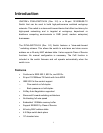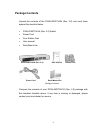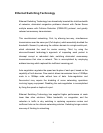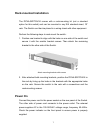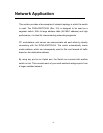3
Ethernet Switching Technology
Ethernet Switching Technology has dramatically boosted the total bandwidth
of networks, eliminated congestion problems inherent with Carrier Sense
multiple access with Collision Detection (CSMA/CD) protocol, and greatly
reduced unnecessary transmissions.
This revolutionized networking. First, by allowing two-way, simultaneous
transmissions over the same port (Full-duplex), which essentially doubled the
bandwidth. Second, by reducing the collision domain to a single switch-port,
which eliminated the need for carrier sensing. Third, by using the
store-and-forward technology’s approach of inspecting each packet to
intercept corrupt or redundant data, switching eliminated unnecessary
transmissions that slow a network. This is accomplished by employing
address learning which replaced the inefficient receiving port.
Auto-negotiation regulates the speed and duplex of each port, based on the
capability of both devices. Flow-control allows transmission from a 100Mbps
node to a 10Mbps node without loss of data. Auto-negotiation and
flow-control may require the disabling of some networking operations
involving legacy equipment. Disabling the auto-negotiation is accomplished
by fixing the speed or duplex of a port.
Ethernet Switching Technology has supplied higher performance at costs
lower than other solutions. Wider bandwidth, no congestion, and the
reduction in traffic is why switching is replacing expensive routers and
inefficient hubs as the ultimate networking solution. Switching brings a whole
new way of thinking to networking.




